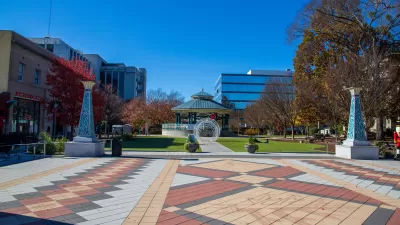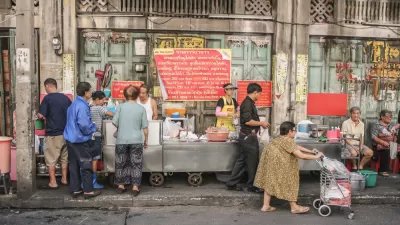Ethan Kent, Enrique Penalosa, and Jonathan Crush offer contrasting perspectives on the effect of informal street vending on public spaces.
Kent, Vice President of the Project for Public Spaces, argues that street vending contributes to the public realm. "Cities first formed as informal street markets, and perhaps the core of where they often go wrong is where they have worked to eliminate that primary function," he says. "When supported and showcased, street vendors, and the life they support, can help create iconic places that are cultural drivers that define cities."
Peñalosa, the former mayor of Bogota, takes the contrary viewpoint. To him, "Vendors on sidewalks are a sign of lack of respect for the human dignity of pedestrians....Vendors in Manhattan are not a sign of a healthy democratic city, but a sign of decay, affecting particularly the low-income citizens with no alternative to public pedestrian space for their leisure."
Finally, Crush, the CIGI chair in global migration and development at the Balsillie School of International Affairs, argues that vendors are a net benefit in that they fill an unmet consumer need. "Pedestrians are not just pedestrians, traversing a safe space to get from point A to point B," he explains. "They are also consumers. If they were not, then the informal traders would not be there in the first place. In other words, the question is not just about incomes and the livelihoods of vendors but the interests of consumer-pedestrians."
"Informal vendors should have every right to sell on the pavements and if some pedestrians and policy-makers don’t like this, then it is incumbent that the vendors have alternative spaces which are directly and continuously accessible to their primary market, the pedestrian consumer," Crush concludes.
FULL STORY: The Big Question: How Can We Reconcile Street Vending With Pedestrian-Friendly Sidewalks?

Study: Maui’s Plan to Convert Vacation Rentals to Long-Term Housing Could Cause Nearly $1 Billion Economic Loss
The plan would reduce visitor accommodation by 25,% resulting in 1,900 jobs lost.

North Texas Transit Leaders Tout Benefits of TOD for Growing Region
At a summit focused on transit-oriented development, policymakers discussed how North Texas’ expanded light rail system can serve as a tool for economic growth.

Why Should We Subsidize Public Transportation?
Many public transit agencies face financial stress due to rising costs, declining fare revenue, and declining subsidies. Transit advocates must provide a strong business case for increasing public transit funding.

How Community Science Connects People, Parks, and Biodiversity
Community science engages people of all backgrounds in documenting local biodiversity, strengthening connections to nature, and contributing to global efforts like the City Nature Challenge to build a more inclusive and resilient future.

Alabama: Trump Terminates Settlements for Black Communities Harmed By Raw Sewage
Trump deemed the landmark civil rights agreement “illegal DEI and environmental justice policy.”

Dear Tesla Driver: “It’s not You, It’s Him.”
Amidst a booming bumper sticker industry, one writer offers solace to those asking, “Does this car make me look fascist?”
Urban Design for Planners 1: Software Tools
This six-course series explores essential urban design concepts using open source software and equips planners with the tools they need to participate fully in the urban design process.
Planning for Universal Design
Learn the tools for implementing Universal Design in planning regulations.
City of Santa Clarita
Ascent Environmental
Institute for Housing and Urban Development Studies (IHS)
City of Grandview
Harvard GSD Executive Education
Toledo-Lucas County Plan Commissions
Salt Lake City
NYU Wagner Graduate School of Public Service





























